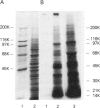Abstract
In order to compare the immunodiagnostic value of excretory-secretory (E-S) antigens derived from adult Brugia malayi worms with somatic antigens derived from adults, microfilariae (Mf) and infective larvae (L3) of these parasites, well defined serum pools from patients with filarial (brugia, bancrofti, loa and perstans) and non-filarial (ascaris, stronglyoides, toxocara, echinococcus, cysticercus and schistosoma) helminth infections were tested against antigens derived from these different life cycle stages of B. malayi in a Staphylococcus aureus radioimmunoprecipitation assay (S. aureus RIA). The adult brugia antigens proved significantly more discriminatory than those of the other parasite stages, with the homologous brugia serum pool also showing greater reactivity to adult than to L3 and Mf antigens. Similar results were obtained when individual sera from patients (rather than serum pools) were tested in the same assay. The most surprising finding was the minimal reactivity seen between the adult filarial antigens and the non-filarial serum pools despite the presence in these pools of strong antibody reactivity with their homologous antigens. The reasons underlying the unexpected specificity of this S. aureus RIA for discriminating among sera from filarial and non-filarial infections were analysed qualitatively by immunoprecipitation techniques. It was found that use of the chloramine-T method for radioiodination resulted in preferential labelling of the low molecular weight (mol. wt) proteins (10-70,000 daltons) in the B. malayi adult somatic antigen and that these antigens were bound primarily by the filarial and not the non-filarial serum pools. These findings suggest that lower mol. wt helminth antigens may show greater species specificity than those with higher mol. wt, and those with higher mol. wt, greater cross-reactivity. If substantiated by further analysis, such results would have important implications for the subsequent isolation of diagnostically important filarial parasite antigens.
Full text
PDF









Images in this article
Selected References
These references are in PubMed. This may not be the complete list of references from this article.
- Ambroise-Thomas P. Immunological diagnosis of human filariases: present possibilities, difficulties and limitations. Acta Trop. 1974;31(2):108–128. [PubMed] [Google Scholar]
- Boros D. L., Warren K. S. Delayed hypersensitivity-type granuloma formation and dermal reaction induced and elicited by a soluble factor isolated from Schistosoma mansoni eggs. J Exp Med. 1970 Sep 1;132(3):488–507. doi: 10.1084/jem.132.3.488. [DOI] [PMC free article] [PubMed] [Google Scholar]
- Bradford M. M. A rapid and sensitive method for the quantitation of microgram quantities of protein utilizing the principle of protein-dye binding. Anal Biochem. 1976 May 7;72:248–254. doi: 10.1016/0003-2697(76)90527-3. [DOI] [PubMed] [Google Scholar]
- Cypess R. H., Karol M. H., Zidian J. L., Glickman L. T., Gitlin D. Larva-specific antibodies in patients with visceral larva migrans. J Infect Dis. 1977 Apr;135(4):633–640. doi: 10.1093/infdis/135.4.633. [DOI] [PubMed] [Google Scholar]
- Fairbanks G., Steck T. L., Wallach D. F. Electrophoretic analysis of the major polypeptides of the human erythrocyte membrane. Biochemistry. 1971 Jun 22;10(13):2606–2617. doi: 10.1021/bi00789a030. [DOI] [PubMed] [Google Scholar]
- GREENWOOD F. C., HUNTER W. M., GLOVER J. S. THE PREPARATION OF I-131-LABELLED HUMAN GROWTH HORMONE OF HIGH SPECIFIC RADIOACTIVITY. Biochem J. 1963 Oct;89:114–123. doi: 10.1042/bj0890114. [DOI] [PMC free article] [PubMed] [Google Scholar]
- Gusmão R. D., Stanley A. M., Ottesen E. A. Brugia pahangi: immunologic evaluation of the differential susceptibility of filarial infection in inbred Lewis rats. Exp Parasitol. 1981 Aug;52(1):147–159. doi: 10.1016/0014-4894(81)90070-9. [DOI] [PubMed] [Google Scholar]
- Hussain R., Hamilton R. G., Kumaraswami V., Adkinson N. F., Jr, Ottesen E. A. IgE responses in human filariasis. I. Quantitation of filaria-specific IgE. J Immunol. 1981 Oct;127(4):1623–1629. [PubMed] [Google Scholar]
- Hussain R., Strejan G., Campbell D. H. Hypersensitivity to ascaris antigens. VII. Isolation and partial characterization of an allergen. J Immunol. 1972 Sep;109(3):638–647. [PubMed] [Google Scholar]
- Kagan I. G. Advances in the immunodiagnosis of parasitic infections. Z Parasitenkd. 1974;45(2):163–195. doi: 10.1007/BF00348533. [DOI] [PubMed] [Google Scholar]
- Kagan I. G. Diagnostic, epidemiologic, and experimental parasitology: immunologic aspects. Am J Trop Med Hyg. 1979 May;28(3):429–439. doi: 10.4269/ajtmh.1979.28.429. [DOI] [PubMed] [Google Scholar]
- Kaushal N. A., Hussain R., Nash T. E., Ottesen E. A. Identification and characterization of excretory-secretory products of Brugia malayi, adult filarial parasites. J Immunol. 1982 Jul;129(1):338–343. [PubMed] [Google Scholar]
- LOWRY O. H., ROSEBROUGH N. J., FARR A. L., RANDALL R. J. Protein measurement with the Folin phenol reagent. J Biol Chem. 1951 Nov;193(1):265–275. [PubMed] [Google Scholar]
- Laemmli U. K. Cleavage of structural proteins during the assembly of the head of bacteriophage T4. Nature. 1970 Aug 15;227(5259):680–685. doi: 10.1038/227680a0. [DOI] [PubMed] [Google Scholar]
- Maizels R. M., Partono F., Oemijati S., Ogilvie B. M. Antigenic analysis of Brugia timori, a filarial nematode of man: initial characterization by surface radioiodination and evaluation of diagnostic potential. Clin Exp Immunol. 1983 Feb;51(2):269–277. [PMC free article] [PubMed] [Google Scholar]
- Neva F. A., Gam A. A., Burke J. Comparison of larval antigens in an enzyme-linked immunosorbent assay for strongyloidiasis in humans. J Infect Dis. 1981 Nov;144(5):427–432. doi: 10.1093/infdis/144.5.427. [DOI] [PubMed] [Google Scholar]
- Sawada T., Sato K., Sato S. Studies on skin test antigen FST for immunodiagnosis of filariasis. I. Electrophoretic analysis and fractionation of antigen FST. Jpn J Exp Med. 1969 Oct;39(5):427–433. [PubMed] [Google Scholar]
- Weiss N., Hussain R., Ottesen E. A. IgE antibodies are more species-specific than IgG antibodies in human onchocerciasis and lymphatic filariasis. Immunology. 1982 Jan;45(1):129–137. [PMC free article] [PubMed] [Google Scholar]
- de Savigny D. H., Tizard I. R. Toxocaral larva migrans: the use of larval secretory antigens in haemagglutination and soluble antigen fluorescent antibody tests. Trans R Soc Trop Med Hyg. 1977;71(6):501–507. doi: 10.1016/0035-9203(77)90144-4. [DOI] [PubMed] [Google Scholar]




